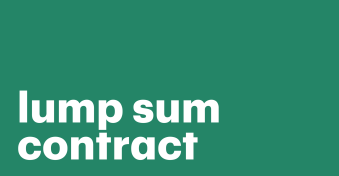Looking to streamline the process of sharing and managing contracts?
To achieve this, you’ll need to have a clear understanding of different types of contract — and one of the types of contract that people get most confused about are cost reimbursement contracts.
That’s why this article will explain what cost reimbursable agreements are, what’s included in them, and how to use and manage a cost reimbursement contract.
Key takeaways
Use a cost reimbursement contract to remove risk for contractors
Make sure to provide cost estimates and fee information in your cost reimbursement agreement
Choose a fixed price contract instead for smaller projects
Use contract management software to streamline your cost reimbursement contracts
What is a cost reimbursement contract?
Let’s say you’re about to start a project with another company.
You’ve agreed to build an office for them.
You can either sign a contract in which the other party pays you the money it will cost you to build that office straight away or a contract in which the other party promises to reimburse the costs once they’ve taken place.
This latter contract is a cost reimbursement contract (which, if they include a profit and the costs, are known as cost plus contracts).
It’s a flexible agreement that requires the buying party to cover all the work costs.
This means that the cost is worked out once the work has been fully completed – letting the buyer reimburse the costs incurred by the contractor.
Of course, this means that the buying party has less control over the project’s price.
However, many cost reimbursement contracts are designed with an estimated cost in mind, and restrictions (such as the maximum price point for building materials) can be agreed on in advance.
What is included in a cost reimbursement contract?
When creating a cost reimbursement contract, you’ll need to know what is included in them.
Here are the main elements of a cost reimbursement contract.
Type of contract
It should be clear in the agreement that it’s a cost reimbursement contract.
As there are also different types of cost reimbursement contracts – which we’ll cover later in this article – you should specify which type it is.
Basic legal details
Of course, a cost reimbursable contract is a legally binding document.
This means that you’ll have to ensure you’ve covered all of the fundamentals to ensure its legal validity.
The key legal details you must include are party names, contact information, effective dates, and signature lines.
All of this is essential if you want your contract to actually count.
Cost estimates
If a selling party doesn’t indicate the expected cost of a product, the buyer is taking on enormous amounts of risk – indeed, they almost certainly won’t sign the contract.
That’s why cost estimates are crucial to a cost reimbursement contract.
Sellers need to be able to provide an accurate estimate of their costs, while the contract should also incorporate a clause that explains what will happen if actual costs exceed this estimate.
Overall project value
Just as cost estimates reduce the amount of risk for the buyer, an indication of the total project value will limit the level of risk for the seller.
That’s because this lets the selling party know how much they will be paid in fees once the project is completed.
This clause should also explain how this fee is determined – think about whether you want to produce a fee according to a fixed amount or a formula based on costs or performance levels.
Coverable cost information
In any contract that deals with costs and payments, it’s crucial that you provide definitions of the different types of recoverable costs.
Be as clear as possible about the costs that buyers will need to cover and those that the sellers will have to carry themselves.
This will reduce the likelihood of any disputes further down the line.
When would you use a cost reimbursement contract?
No general rule explains when you should use a cost reimbursement contract.
That’s because it all depends on the amount of risk your organization is willing to take on – and this will vary according to the size of your business and the financial demands of the project.
However, you should generally use a cost reimbursement contract when the amount of uncertainties in a project means that a fixed price contract would be too risky.
If your project is dynamic or dependent on changeable market conditions, a cost reimbursement contract is your best option.
For the seller, a cost reimbursement contract is a great way to ensure that you remain in the driving seat of a project.
The buying party will cover those, and you won’t have to worry about spiraling costs or surprise inefficiencies.
For the buyer, it helps avoid paying upfront for a job that may or may not meet your expectations.
By only paying the costs after the project completion, you can ensure it’s finished up to the requested standard – rather than risking your money being taken and nothing being produced.
6 types of cost reimbursement contracts
If you decide to use a cost reimbursable agreement in your project, it’s essential that you know the different types of cost reimbursement contract. Here are the main ones.
Cost contracts
This is when the contract simply covers the costs of the project.
The contractor won’t receive any profit or fee, meaning this is a rare cost reimbursement contract outside of the non-profit sector.
Cost-sharing contracts
In this type of contract, the contractor and the buyer share the costs according to the previously agreed formula.
Again, no additional fees are involved.
Cost-plus-fixed-fee (CPFF) contracts
This is one of the more common forms of cost reimbursement contracts.
Once the project is completed, a fee is negotiated ahead of the project, which is received along with reimbursement for the costs.
Many of these contracts will include a provision for this fee to be revised according to performance-related criteria.
Cost-plus-incentive-fee (CPIF) contracts
in this contract, the fee received by the contractor is adjustable.
Minimum and maximum fees are agreed ahead of the work, while targets are determined to produce the final fee.
This type of contract incentivizes the contractor to keep costs low as this will directly impact the fee they receive – making it a great way to share risk.
Cost-plus-award-fee (CPAF) contracts
This is another way of providing a performance-related incentive.
According to an assessment of performance, an additional fee can be given to the contractor on top of the reimbursement and a pre-agreed fixed fee.
Cost plus percentage of cost (CPPC) contracts
In this type of contract, an additional fee is added as a percentage of the cost.
This is useful for industries with supply chain disruptions or a shortage of skilled workers, as it prevents the seller from coming out at a loss.
What is an example of a cost reimbursement contract?
One of the most common examples of when to use a cost reimbursement contract is in the construction sector.
The cost of making a building can be very high, so it makes sense for the buying party to protect themselves against the risks that come with this high cost.
In this example, the buyer would determine which type of cost reimbursement contract is most suitable and negotiate a cost estimate and fee structure with the construction company.
Once the building has been completed and the buyer is happy, the costs will be reimbursed and the fee paid.
Another cost reimbursement contract example is outsourced software development.
This is because making new software can also be costly while using a cost reimbursement plus fee contract allows the buying party to have more confidence in the quality of the software.
How to manage cost reimbursable contracts: 4 top tips
Cost reimbursable contracts can be complex legal documents.
That’s why it’s crucial that you manage them carefully.
Here are four top tips that can help.
Use contract management software
By far, our most important tip is to use contract management software.
This will take most of the hard work out of your hands and into the secure control of a well-designed and intelligent piece of software.
It will also ensure that you and the other party can easily access the contract on a cloud-based platform while allowing you to use an eSignature and collaborative editing tools to make managing the contract as easy as possible.
Without contract management software, you risk losing track of your contract, leading to inefficiencies and failures in your contract management process – especially damaging in the complex world of cost reimbursable contracts.
Keep on top of time
There’s no doubt managing a cost reimbursement contract can take a lot of time, as you must negotiate cost estimates, fee agreements, and payment structures.
Set specific deadlines for tasks, and keep tabs on them with your contract management software.
Make contracts clear and accessible
A cost reimbursement contract should be easily accessible to both parties.
This will let the contractor repeatedly refer to the document to manage their costs when completing the work while letting the buyer easily prepare for fees.
Contract tracking can clarify this during every part of the contract management process.
Automate workflows
When paying costs and fees, this can often be determined by a complex formula agreed on in the contract.
Automating this workflow can save a lot of time and worry.
Issues of a cost reimbursement contract: pros and cons
Before you decide to use a cost reimbursement contract, it’s important that you’re able to recognize the pros and cons of using a cost reimbursable agreement:
Pros of a cost reimbursement contract
- Flexibility and adaptability: Using a cost reimbursement contract allows for projects to be completed in a way that is adapted to real-world conditions and changes to things such as price and availability.
- Quality incentive: With fees often related to costs – and payment dependent upon a quality final result – cost reimbursement contracts can be a great way of ensuring quality assurance.
- Draw on contractor expertise: By letting contractors have more flexibility over costs, you’ll be able to draw on their expertise – they can choose to go for a slightly pricier material, for instance, if they know it’s more effective.
Cons of a cost reimbursement contract
- Uncertainty: Without a fixed fee to be paid in the future, long-term financial planning can be complex for both parties.
- Requires close monitoring: To ensure that costs are kept low, the buying party has to monitor the actions of the contractor closely.
Cost reimbursement contract vs. fixed price: what are the key differences?
The opposite of a cost reimbursement contract are fixed price contracts.
Here are the key differences:
- Fees: In a fixed price contract, fees are fixed from the beginning regardless of cost.
- Risk: In a fixed price contract, the contractor carries much risk as costs may be higher than the fee.
- Suitability: Fixed price contracts are better suited for small-scale, low-risk projects.
Customize, negotiate, and eSign complex contracts with robust contract management software
Cost reimbursement contracts are a great way to spread the risk on large projects.
However, they can be challenging to manage.
This is why contract management software, like PandaDoc, is so essential.
By providing contract templates, collaborative editing tools, and eSignature processes, you can ensure that both parties are up-to-date throughout the process.
Frequently asked questions
-
Cost reimbursement on a project is when the buyer reimburses the contractor for the costs they have incurred completing a project.
-
Both parties carry some element of risk. The seller has to buy materials and pay for labor out of pocket. However, the buyer carries more risk, as they have to reimburse all costs.
-
The main limitation of a cost reimbursement contract is that it makes future financial planning more difficult for the buyer. Additionally, monitoring is necessary as there is less incentive for the seller to be cost-efficient.
-
No. While a cost reimbursement contract can include labor costs, a stand-alone labor hour contract doesn’t include reimbursement for materials.
-
If your project is large-scale and carries many risks, a cost reimbursement contract is well-suited. However, a fixed price contract is likely to be more suitable for smaller, low-risk projects.
Disclaimer
PandaDoc is not a law firm, or a substitute for an attorney or law firm. This page is not intended to and does not provide legal advice. Should you have legal questions on the validity of e-signatures or digital signatures and the enforceability thereof, please consult with an attorney or law firm. Use of PandaDoc services are governed by our Terms of Use and Privacy Policy.


